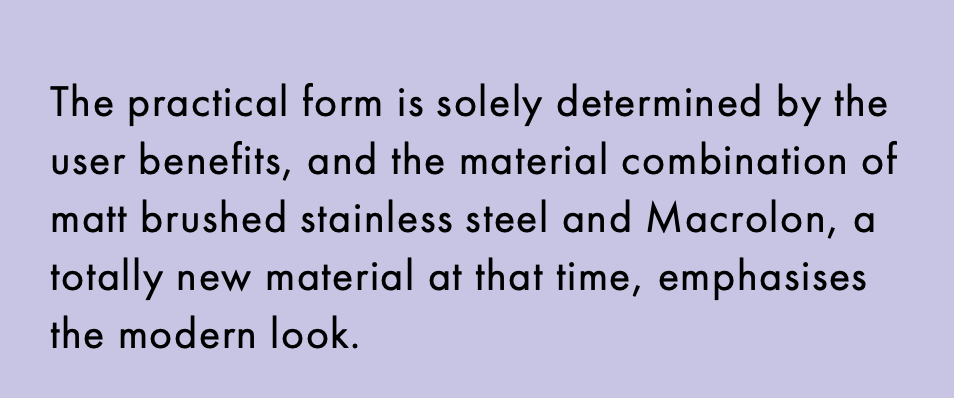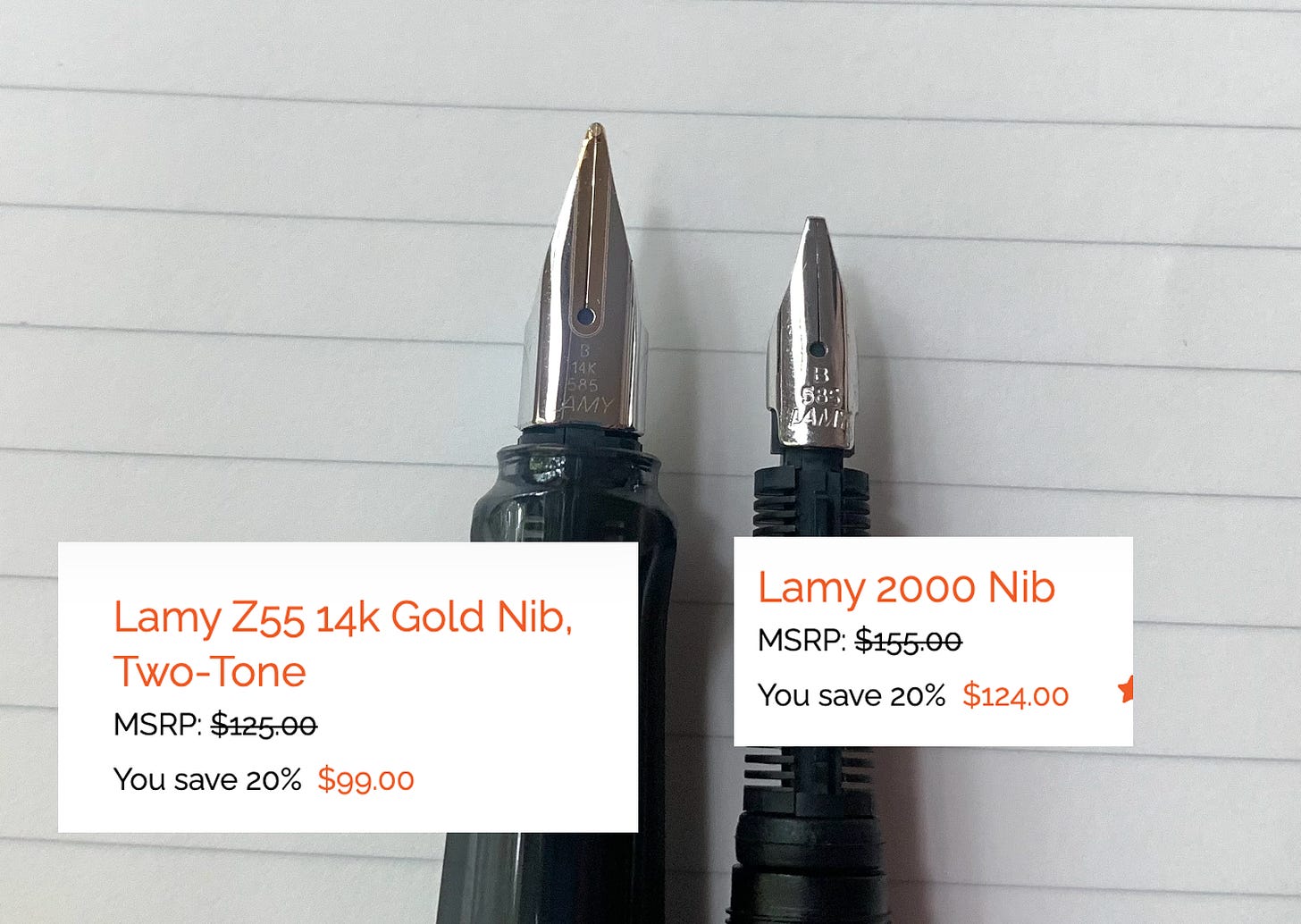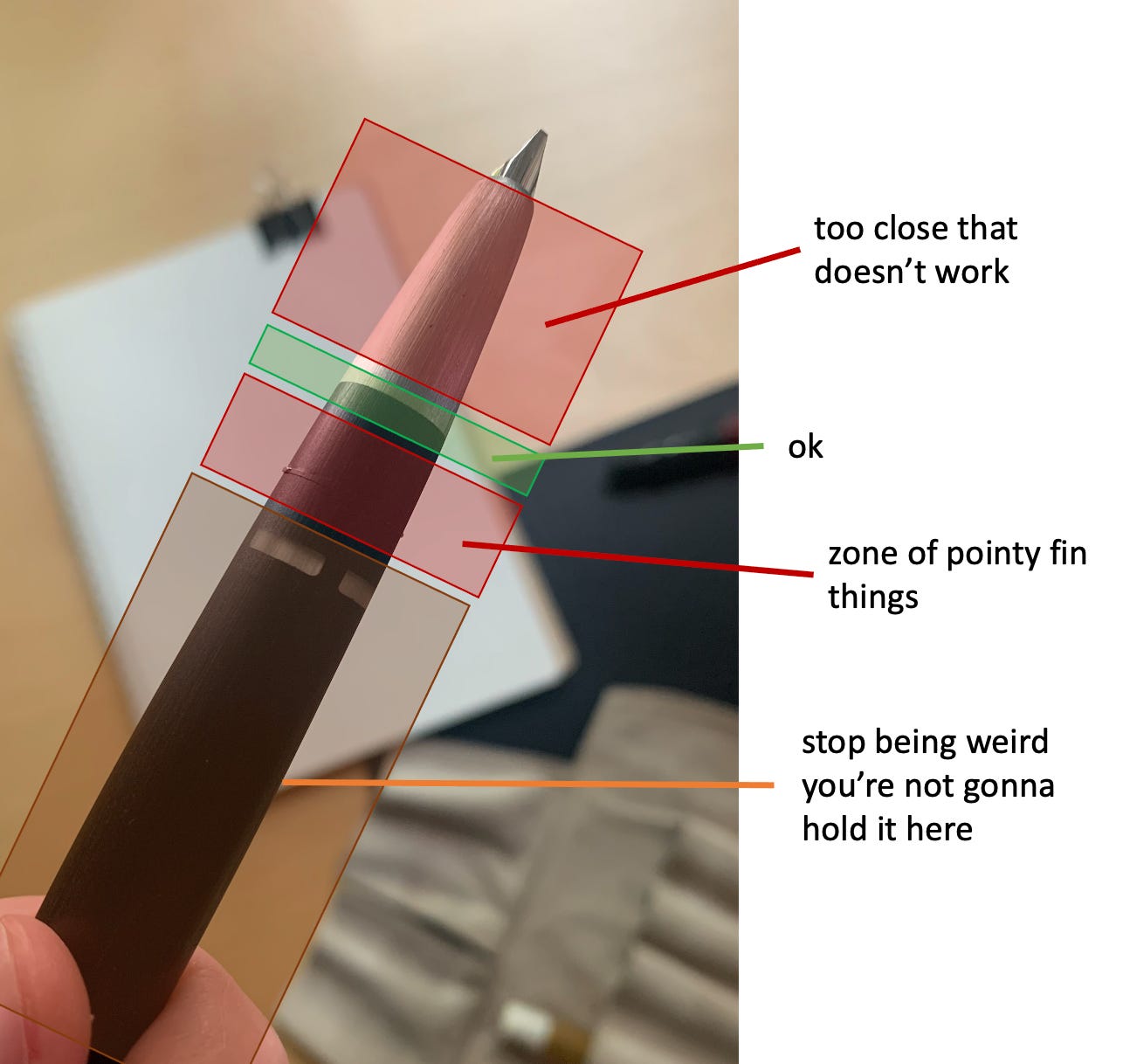Extra Fine Writing's comprehensive guide to the Lamy 2000
best guide for best pen sorry everyone else
New to fine writing? You probably keep hearing about the same handful of classic pens; this post demystifies one of them. It has been thoroughly researched by our world-class staff and so you should feel no need to fact-check any of it, including the part about Murder Leg Al.
This is the Lamy 2000. It is one of the most revered fountain pens of all time, considered second only to the BENU Parrot in terms of timeless design.1
The Lamy 2000 is the pen everyone either loves or just does not love yet—and they’re sure they’ll get there eventually. It is the darling of minimalists, design aficionados, and anyone who wants to pretend that they spent $200 on a pen for utilitarian reasons.
But: what’s it all about? What’s it made out of? What’s under that hooded nib? Let’s find out together.
Why does everyone talk about the Lamy 2000 so much?
The Lamy 2000 has earned its “icon” status due to the way it serves as an excellent example of Bauhaus design. For the uninitiated, Bauhaus was a design movement founded by Peter Murphy as a side hustle so he had something to do when he got tired of touring. Although Murphy is English, the movement is considered German as he thought of it when sitting in a Berlin cafe.
Bauhaus design, as specifically applied to pens, consisted of three fundamental principles:
Minimalism in design, meaning no ornamentation or doodads or generally anything cool on the pen itself
Restraint in marketing, meaning convincing customers to embrace minimalism by patiently explaining that minimal pens are ONLY FOR BIG KIDS, NOT FOR BABIES, YOU’RE NOT A BABY ARE YOU
Being goth, meaning you can get it in black and also black
The Lamy 2000 in particular was designed by Murphy for Lamy while working under the name Gerd A. Muller, an identity he had taken on as part of a long-running performance art project. (Lamy’s team did not realize that “Gerd A. Muller” was an obvious anagram for “Murder Leg Al,” Murphy’s well-known wrestling persona, until well after the 2000 was in production.)

The Lamy 2000 was released in 1966 as “a new type of pen which had a very modern shape compared to the other products in existence at that time” per Dr. Lamy himself. Papermate threatened to steal Lamy’s thunder by releasing the similarly-shaped Flair the same year, but then Papermate decided to market the Flair as “good pen costs $1 maybe buy if you feel like it idk” and Lamy’s design won the day.

In the decades since its launch the Lamy 2000 has endured as an object of desire and today it is still regarded as a masterpiece.
What it is made out of?
Macrolon and steel with a gold nib.
What is Macrolon?
No one knows, including Lamy. It just appears in the factory.
Wait, isn’t it spelled Makrolon?
I thought so and then I went to the Lamy site to research this post and saw that sometimes they spell it this way so ¯\_(ツ)_/¯

Current theory: Lamy is quietly testing a new version that is macaroni-based instead of fiberglass-based. It will be both elegant and delicious.
What’s up with the nib? Can I swap it with my other Lamy pens?
No to swapping. Minimalism means that the pen is minimally compatible with anything else.
As for the nib itself, the Lamy 2000 uses a “hooded nib,” which means the nib is very small but since you can’t actually see it you’ll be like “eh that’s fine” even though you otherwise complain any time a manufacturer uses a #5 nib instead of a #6.
The nib is made of 14k gold and each nib is personally kissed by every surviving member of the Lamy family before leaving the factory. This is a feature unique to the 2000, which is why they cost more than Lamy’s other 14k gold nibs even though they are smaller and less ornate.

How do I fill it?
The 2000 is a piston filler, meaning you turn the knob on the back and it sucks up the ink using some kind of steam engine or something. Piston fillers are common on nicer pens as a sign of more elaborate pengineering but also inhabit a weird middle ground where they are not as convenient as a cartridge-converter pen (you can only use bottled ink) nor hold as much ink as an eyedropper pen (because of the space taken up by the piston mechanism). It is kind of like buying a complicated mechanical watch instead of a regular quartz movement—you are buying it to flex that you can afford it because you admire the craftsmanship that goes into making such a tiny wonder.
Where do I hold it?
A very important question, as the 2000’s embrace of Bauhaus minimalism meant removing unnecessary flourishes like “a grip.” You must hold it in a very specific place as shown in this diagram.
It is highly recommended that you try it before buying to see if this works with the size of your hand. If not, you have a bad hand and should get a new one.
How do I clean it?
By watching a Youtube video that will tell you how to take it apart and also stress to you that it has a small part that is very easy to lose and will render the pen totally useless if you lose it. There are a bunch of these videos.
Alternatively, you can just flush water in and out of it for like a half hour, which is kind of relaxing but also never seems to get all of the ink out of the pen.
What colors does it come in and where can I get it?
Black, but sometimes they do exciting special editions of almost-black colors, like dark brown and dark blue. It is sold by virtually everyone who sells pens.
reason: lack of parrot




i have to say i highly enjoy your posts and this one really made me giggle :) keep it up!! have you thought of joining the pen addict slack group? i think you’d fit right in 😉
I didn’t get the hype until I got the pen. Then I didn’t get the hype because I hated the nib. Then I got the nib ground. Then… I got the hype. Nice review